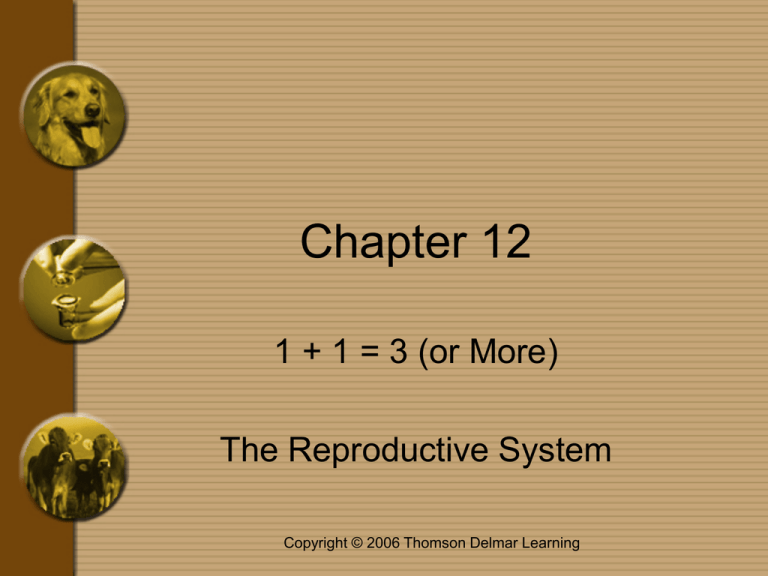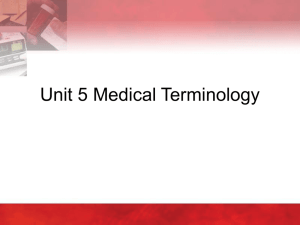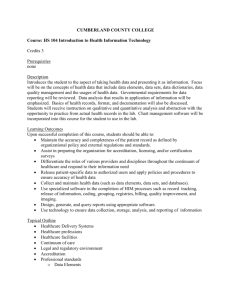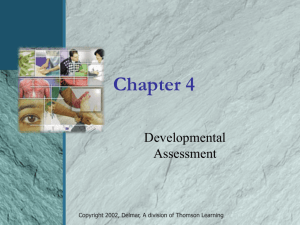Chapter 12 - Delmar
advertisement

Chapter 12 1 + 1 = 3 (or More) The Reproductive System Copyright © 2006 Thomson Delmar Learning The Reproductive System • The reproductive system is responsible for the act of producing offspring – needs both male and female organs • Theriogenology means animal reproduction • The reproductive organs are called genitals – genit/o refers to the organs of reproduction Copyright © 2006 Thomson Delmar Learning The Male Reproductive System • The male reproductive system is responsible for the production and delivery of sperm to the egg to create life • The structures of the male reproductive system include the scrotum, testes, epididymis, vas deferens, accessory sex glands, urethra, and penis Copyright © 2006 Thomson Delmar Learning The Scrotum • The scrotum or scrotal sac is the external pouch that encloses and supports the testes – The combining form for the scrotum is scrot/o • The area between the scrotum and the anus in males is called the perineum – The combining form for the perineum is perine/o Copyright © 2006 Thomson Delmar Learning The Testes • The testes or testicles are the male sex glands that produce spermatozoa – The combining forms for the testes are orch/o, orchi/o, orchid/o, test/o, and testicul/o – Testis is the singular form of testes • The testes make spermatozoa – The combining forms for spermatozoa are sperm/o and spermat/o Copyright © 2006 Thomson Delmar Learning The Epididymis • The epididymis is the tube at the upper part of each testis that secretes part of the semen, stores semen before ejaculation, and provides a passageway for sperm – The combining form for the epididymis is epididym/o Copyright © 2006 Thomson Delmar Learning The Ductus Deferens • The ductus deferens is the tube connected to the epididymis that carries sperm into the pelvic region toward the urethra Copyright © 2006 Thomson Delmar Learning The Accessory Sex Glands • The accessory sex glands include the seminal vesicles, prostate gland, and bulbourethral gland – Seminal vesicles secrete thick substance that nourishes sperm – The prostate gland secretes a thick fluid that aids in the motility of sperm – The bulbourethral glands secrete a thick mucus that acts as a lubricant for sperm • Not all glands are present in all species Copyright © 2006 Thomson Delmar Learning The Urethra • The urethra is a singular tube passing through the penis to the outside of the body that serves both reproductive and urinary systems – The combining form for the urethra is urethr/o Copyright © 2006 Thomson Delmar Learning The Penis • The penis is the male sex organ that carries reproductive and urinary products out of the body – The combining forms for the penis are pen/i and priap/o Copyright © 2006 Thomson Delmar Learning The Female Reproductive System • The female reproductive system is responsible for the creation and support of new life • The structures of the female reproductive system include the ovaries, uterine tubes, uterus, cervix, vagina, vulva, and mammary glands Copyright © 2006 Thomson Delmar Learning The Ovaries • The ovaries are a small pair of organs located in the caudal abdomen • The ovaries produce estrogen, progesterone, and ova (eggs) • The combining forms for ovary are ovari/o and oophor/o Copyright © 2006 Thomson Delmar Learning The Uterine Tubes • The uterine tubes are paired tubes that extend from the cranial portion of the uterus to the ovary (although they are not attached to the ovary) • The uterine tubes carry ova from the ovary to the uterus and transport sperm • The combining form for the uterine tubes is salping/o Copyright © 2006 Thomson Delmar Learning The Uterus • The uterus is a thick-walled, hollow organ with muscular walls and a mucous membrane lining • The combining forms for the uterus are hyster/o, metr/o, metri/o, and uter/o Copyright © 2006 Thomson Delmar Learning The Cervix • The cervix is the caudal continuation of the uterus and the cranial continuation of the vagina • The cervix prevents foreign substances from entering the uterus • The combining form for the cervix is cervic/o Copyright © 2006 Thomson Delmar Learning The Vagina • The vagina is the muscular tube lined with mucosa that extends from the cervix to outside the body • The vagina accepts the penis during copulation • The combining forms for the vagina are colop/o and vagin/o Copyright © 2006 Thomson Delmar Learning The Vulva • The vulva is the external opening to the urogenital tract that leads into the vagina – The perineum is the region between the vaginal orifice and anus in females • The vulva consists of the vaginal orifice, vestibular glands, clitoris, hymen, and urethral orifice • The combining forms for the vulva are vulv/o and episi/o Copyright © 2006 Thomson Delmar Learning The Mammary Glands • • The mammary glands are milk-producing glands in females The number of mammary glands varies with the species – Litter-bearing species have mammae – Large animals have udders with teats • • Mammary glands are composed of connective tissue organized into lobes, lobules, and alveoli The combining forms for the mammary glands are mamm/o and mast/o Copyright © 2006 Thomson Delmar Learning The Placenta • The placenta is the female organ of mammals that develops during pregnancy and joins mother and offspring for exchange of nutrients, oxygen, and waste products – The placenta is often referred to as the afterbirth Copyright © 2006 Thomson Delmar Learning The Placenta • The umbilical cord is the structure that forms where the fetus communicates with the placenta • The umbilicus is the structure that forms on the abdominal wall where the umbilical cord was connected to the fetus – The combining form for umbilicus is umbilic/o Copyright © 2006 Thomson Delmar Learning The Placenta and Associated Structures • The innermost membrane that envelopes the fetus is the amnion • The innermost layer of the placenta that forms a sac between itself and the amnion is the allantois • The outermost layer of the placenta is the chorion Copyright © 2006 Thomson Delmar Learning Pregnancy and Birth • Pregnancy is the condition of having a developing fetus in the uterus and is the time period between conception and parturition – The combining form for pregnancy is pregn/o • Gestation is the period of development of the fetus in the uterus from conception to parturition and is the term more commonly used in animals – The combining forms for gestation are gest/o and gestat/o Copyright © 2006 Thomson Delmar Learning Pregnancy and Birth • Parturition is the act of giving birth – The combining form for giving birth is part/o • Parturition is divided into stages: – first stage = dilation of the cervix – second stage = uterine contractions and delivery of the fetus – third stage = separation of the placenta from the uterus Copyright © 2006 Thomson Delmar Learning Medical Terms for the Reproductive System • Additional terms for reproductive system tests, pathology, and procedures can be found in the text • Review the Flash! CD program to make sure you understand these terms Copyright © 2006 Thomson Delmar Learning






